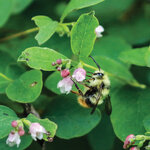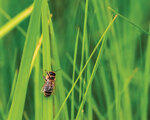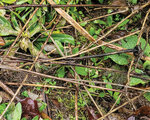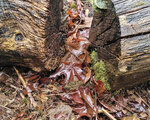



While people may be inclined to get rid of the crisp brown remains of yard plant debris in the spring, local horticulturists warn people to reconsider removing it too early in the year.
The dead plant matter actually plays a vital role in the ecosystem. Bugs dwell within the decaying material, overwintering and emerging in the spring and serve as an important part of the food chain, Clark County Master Gardener Program coordinator Erika Johnson said.
“These critters, in turn, make nutritious food for birds, frogs, salamanders, snakes and many mammals,” Johnson said.
Decaying plant matter may be unsightly, but it’s important to leave it undisturbed until warm spring weather arrives. Urban habitats provide limited shelter for insects, and flowerbeds and gardens provide invaluable space for hibernating and laying eggs.
“These insects are all around us, often hidden in plain sight,” Johnson said. “Butterflies and moths usually overwinter as chrysalids, blending in with leaves and dead plant stalks. Some native bees hide in leaf litter or create burrows underground, while others utilize natural cavities, such as hollow stems from pithy plants and grasses or tunnels in dead wood. Beetles may overwinter in piles of organic debris, such as leaves, bark and mulch,” Johnson said.
If property owners wish to tidy their flower beds and gardens, they should wait until warm weather. Johnson encourages people to consider letting the debris decay naturally, which is the best way to support bugs.
“A great and easy way to help support the entire food web is by simply leaving fall plant debris where it falls or by raking it into a garden bed. Left alone all winter, the rain, wind and sun will break it down until it is eventually incorporated into the soil,” Johnson said.
Removing decaying plants too early can result in insects waking up within a waste bin or another unsuitable environment and dying. In Clark County, waiting until April to remove plant debris is best, according to the Washington Department of Fish and Wildlife’s (WDFW) website.
Decaying plant matter also provides food to freshly hatched bugs and those awakening from long winter hibernation. Johnson said that insects, worms, snails and slugs eat the fungi growing on the dead material.
Property owners wishing to support insects and their vital role in the ecosystem can landscape their property to provide more habitat.
Removing or reducing grass lawns with plants is the best way to support insects. Clipped and tidy grass lawns make poor habitat for bugs, Johnson said.
Native plants with pithy or hollow stems, like caneberries, such as blackberries and raspberries, and wild roses, such as Nootka rose, provide the best habitat for many native bees and other insects, Johnson said. Pithy plant stems dry and leave hollow chambers during the fall, where insects lay eggs.
Water is also important for insects. It keeps bugs hydrated, provides minerals and is used to create nesting mud, according to the WDFW. Placing a shallow dish of water or bird bath can also attract native insects, Johnson said.
Man-made habitats known as bug hotels have also been popular among insect enthusiasts. The nature-inspired and aesthetically pleasing habitats provide various nesting options for insects, such as solitary bees, wasps, ladybugs, beetles and spiders, according to the University of Vermont’s master gardener program.
Bug hotel benefits have yet to be verified, and Johnson recommends property owners research how to construct one to simulate a natural habitat.
For more information about protecting overwintering insects, visit WDFW’s pollinator guide or wdfw.wa.gov/species-habitats/living/habitat-at-home/pollina tor-habitats or Clark Conservation District’s information page at clarkcd.org/pollinators-pests.